In his landmark 1939 publication The Hudson, Carl Carmer wrote “The lands on the Hudson in the last fifty years have been absorbed to an amazing degree by institutions… The Roman Catholic Church owns more land on the shores of the Hudson than any other religious organization and houses tens of thousands of its votaries upon the old estates. Other denominations, however, have also taken advantage of the opportunities the valley offers… Further inroads on the old estates have been made by secular institutions.” Carmer claimed this to be a victory for the people, who had previously been unable to obtain riverfront land that a few wealthy aristocratic families held for centuries as their estates.
At the beginning of the 21st century, many of these institutions have shut their doors too, as religious congregations have dwindled and massive state and local facilities, including hospitals, have closed down. One institution that still owns several large estates along the Hudson River is the Holy Spirit Association for the Unification of World Christianity, or the Unification Church, whose founder and leader Rev. Sun Myung Moon, the self-proclaimed savior of humanity, died this week.
The Unification Church once owned hundreds of acres in Irvington and Tarrytown, in Westchester County, comprising all or parts of at least four estates. In Irvington, there is East Garden. In Tarrytown, there is Belvedere and Gracemere, and parts of the former Graystone estate. At Barrytown in Dutchess County the Church owns the former Massena estate, which was already made a religious institution and school earlier in the 20th century. Rev. Moon himself lived in at least one or two of houses at one time or another, but mostly the mansions and estate buildings just seem to be used as apartments for his followers.
There seems to be no evidence that the Unification Church will disappear in the wake of its leader’s death and vacate its large landholdings. But as Moon aged and his public appearances diminished in the last two decades, the Association’s ambitions also waned. The church sold about 200 acres to the Town of Greenburgh which opened the land as Taxter Ridge Park. Another 37 acres were sold to Westchester County for the formation of a park that will eventually link Lyndhurst, Sunnyside, and the Old Croton Aqueduct. More land at 548 South Broadway in Tarrytown was sold to a housing developer who erected homes much too big for their lots. Plans to build a church adjacent to Belvedere seem to have dissipated.
___________________________________________
EAST GARDEN
High on a hill east of Broadway is the stone mansion of the East Garden estate. Large chateaux and castle-like mansions have stood on this ridge in south Tarrytown and Irvington since the 1850s. Many of the homes were altered as tastes changed; some burned and were rebuilt in part or wholly. It seems that the East Garden mansion is more of a 20th-century construction that incorporates the walls of an earlier home. Hudson River travel guides of the late 19th-century referred to the “high-pointed tower” of the Cunningham Castle, which occupied this spot and burned in 1901 when it was owned by John S. Huyler. The architect of the original Cunningham house was given as (James Jr.) Renwick and Sands. I have not thoroughly researched this house’s history, but it seems to have been the center of the Unification Church activities in Westchester in recent years.
West front of the mansion. February 2007.
Here is an aerial photograph from bing.com that shows a better view of the east side of the mansion.
A cottage on the East Garden estate.
____________________________________________
BELVEDERE
Belvedere may have been built about 1920 by Caspar and Florence Whitney. Adjacent to the south boundary line of the Lyndhurst estate, Belvedere comprised two former estates including that of Henry Worthington. The two older mansions were demolished when the new estate was developed (Worthington’s burial chapel still stands in the Town of Greenburgh). Caspar Whitney was an author and outdoorsman (caricatured here). A year before Caspar died, the Whitneys sold the estate to Dr. Philip Cole in 1928. My friend Paul Barrett, an expert on these mansions in Tarrytown, believes that Cole (or the Whitneys) actually remodeled the existing 19th-century brick mansion that once was the home of Roswell Skeel. That scenario is quite likely, as we have seen that numerous other nearby homes underwent major alterations rather than complete tear-downs and rebuilds.
Cole, a collector of western art, named the estate Zeeview (it is not known what the Whitneys called the estate). An aerial view from the time that Cole owned the property can be found at the Robert Yarnall Richie collection. Here is the modern-day aerial view from bing.com.
Cole’s collection of western art resides in the Gilcrease Museum in Tulsa, OK. Their website has several excellent historic photographs of Zeeview/Belvedere. Samuel Bronfman acquired the Zeeview estate in 1960 and re-christened it Belvedere. In 1972, a year after Bronfman died, the Unification Church purchased Belvedere, and it seems that Rev. Moon made it home for some time. The mansion and outbuildings today are likely converted into apartments; the grounds are occasionally used for large-scale church events.
North front of the mansion, September 2012. Unlike most Hudson River homes that parallel the shoreline, this house was built on an axis that makes the main facades face north and south, perpendicular to the river. September 2012.
East Garden and Belvedere are both closed to the public, so these are all through-the-fence photos.
A brick tower and shingled addition of a service building at the northwest corner of the estate. The brick tower may be a remnant from one of the 19th-century estates that predate Zeeview/Belvedere.
A cowboy-and-horse weather vane, perhaps installed by Dr. Cole.
____________________________________________
GRAYSTONE
This brick barn was built in the 1890s for Louis Stern who owned the Graystone estate. Architect Robert Henderson Robertson designed this barn which is now an apartment building for the Unification Church. Robertson also designed at least two notable mansions in Tarrytown and Irvington, Richmond Hill and Shadowbrook.
The Graystone estate originally included about 100 acres when developed in the 1850s. The main (south) half of the estate is currently undergoing redevelopment as more massive homes are planned on what even the developer calls “spectacular…wooded wonderland.” How spectacular and wooded this wonderland will be once 20 huge homes are built here is doubtful. By the way, the developer used a few of my photos (uncredited and without asking me, of course) in their promotional slide show that I just linked to.
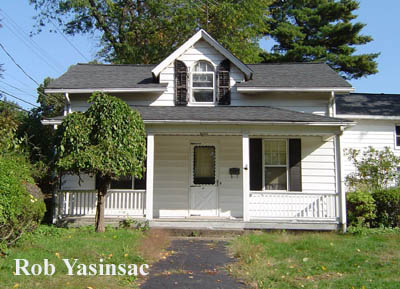
This perfectly-good farmhouse on Sheldon Avenue in Tarrytown, another remnant of the old Graystone estate, was demolished after the Unification Church sold it to a developer of oversize houses. In this time of economic uncertainty, it is quite foolish to destroy right-sized houses and build homes that are economically unsustainable. Those McMansions may be also apartment buildings in the not-too-distant future. Who is building individual homes for people with regular budgets?
____________________________________________
GRACEMERE
Nestled among still-spectacular woodlands is the 80+ acre estate Gracemere. The mansion, Gracemere Hall, was built in the 1860s or possibly even in the 1850s. It was occupied by Charles Graef in the late 1800s before it became the domain of Henry King and Mary Browning in the early 1900s. Henry Browning owned a men’s clothing company and store in New York City that reportedly produced uniforms for the United States armed forces in World War I. When each of the Brownings’s four daughters married, they built homes for them too.
Gracemere Hall as viewed from the west. Its mansard roof and dormer windows are typical of Civil-War era houses. Photographs from September 2012.
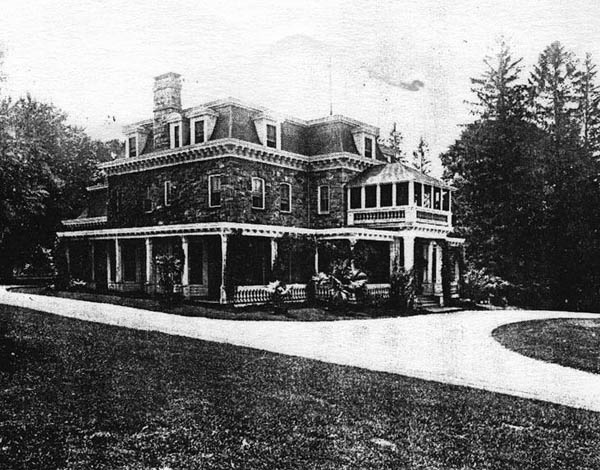
Gracemere Hall about 1918, from a very rare and awesome book entitled In Irving’s Country.
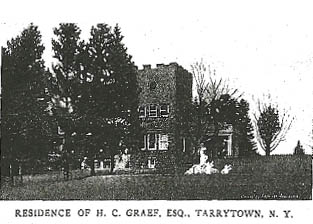
A view from the south shows a crenelated tower.
Gracemere has been described as a “magic kingdom” by former residents of the estate and as a “land of enchantment” in local newspaper articles.
The gate pillars and gatehouse, now owned by the Unification Church.
The home of Katherine Browning and Alfred Thurber, now owned by the Unification Church.
The home of Marjorie Browning and George Dickinson, now privately owned.
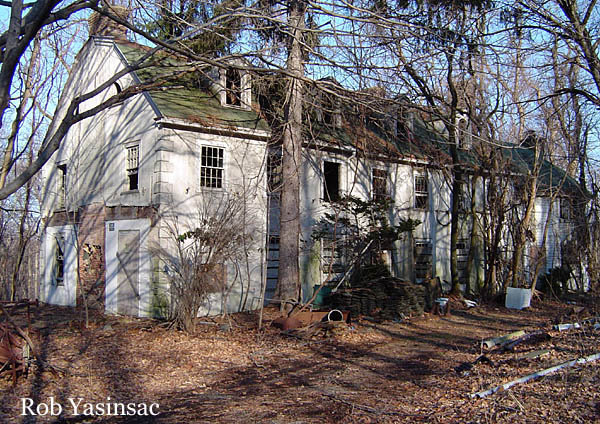
The home of Adelaide Browning and H. Stuart Green. Abandoned for a decade or two (or more?), the house was demolished about 2006. More photographs of this house can be seen here.
The home of Natalie Browning and Grant Small. I am certain that I have a better photographic survey of the Gracemere estate including winter-time images that show the homes much better. But I cannot find those files at present.
An abandoned estate building that may have been a powerhouse.
On the estate there are two small ranch houses, in addition to several homes of at least two generations of construction. The one-story houses are abandoned. In the mid-1940s, Walter Kocher bought the estate (Henry Browning died in 1936) and converted the mansion and other buildings into apartments. Many of the old estates of Tarrytown and Irvington ceased to be private estates around World War II and were divided up for housing tracts or converted to offices.
Interior view of one of the ranch houses.
Pennybridge, as the general area of the estate is known today, is still a land of enchantment, with castles and old mansions and large pieces of (as yet) undeveloped woodlands. In the winter I ice skate on a pond in the deep of the woods, and in the spring I go at night and listen to the peepers in the swamp.
(Some information cited in this part comes from an unpublished family memoir by Linda Hoeschler, who grew up at Gracemere.)
____________________________________________
MASSENA
Located north of Rhinebeck at Barrytown is the Unification Theological Seminary, housed on the grounds of what was once an estate known as Massena. The current brick mansion dates to 1886 and replaced John LLoyd Aspinwall’s country house, which was enlarged from the original 1797 John R. Livingston wood-frame house. William Appleton Potter designed the new brick house for Mrs. Aspinwall after a fire in 1885 destroyed the earlier house. Massena is the only one of the Unification Church houses to be featured in John Zukowsky and Robbe Pierce Stimson’s great book Hudson River Villas.
The Christian Brothers became owners of the estate in 1928 and they built the seminary that stands opposite the front (east) entrance to the mansion. The Unification Church has been here since 1974. The grounds of the seminary are open to the public. There is a labyrinth on the property too, if you are into such things.
Photographs of Massena August 2010.
Inside the front door.
A first floor room.
Christian Brothers Seminary.
BONUS:
The Reverend Moon was not the only landowner along the shores of this river to believe himself to be God among us. Heck, not even the first guy in his neighborhood. A couple of houses away was the home of Father Divine, founder of the Peace Mission movement, “a savior to some, a hustler to many more.” Quoting again from Robert Marchant of the Journal News, Father Divine “claimed to have God-like powers and the ability to bring salvation to the faithful, but critics said his gift was the power to defraud the gullible through a strange mix of Christianity, cultism and self-help ideology” (July 29, 2000).
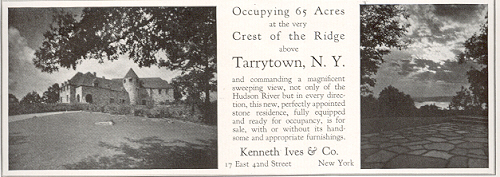
Real estate advertisement for the Father Divine house.
Father Divine’s mansion stood, and still stands, at the top of the hill behind the Graystone estate and just west of the Gracemere property. Some photographs of the house from the 1940s can be found here. Father Divine occupied the house personally along with a staff of 30 to 40 “angels” (he called his estates Heaven). The Robert Yarnall Richie collection also has an aerial photograph of this house with the information that the house was built about 1930. I thought I had a photo or two myself, but likewise I cannot find any in my collections. The house is privately owned today.
Additionally, an adjacent mansion is owned by the ambassador to Nigeria, though I understand that the ambassador rarely occupies this house.
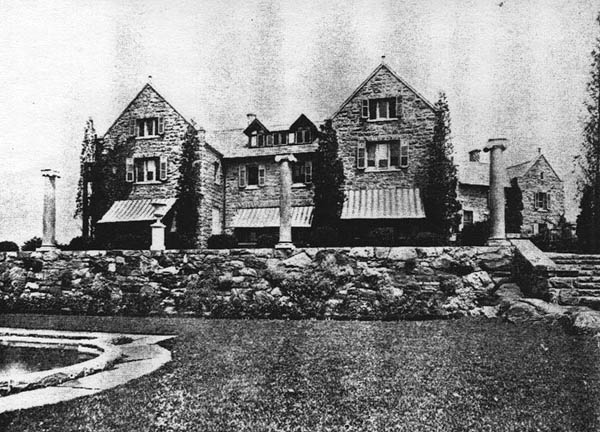
The McEwen Residence about 1918. Now the property of the Ambassador of Nigeria.

wow, that’s a lot of tax-free livin’
maybe i should think about becoming a savior…
Hi Rob,
After sitting thru two political conventions, it was a real pleasure to “tour” thru the “Moonscape”. An essay, well done.
– Fred
Lot of eye candy in this one!
Perhaps presidential nominees and self-appointed holy saviors are two sides of the same coin.. but either path is a good way to acquire some eye candy!
WONDERFUL PICTURES AND NEWS, I RECOGNISE GRACEMERE ESTAE.
I AM THRILLED WITH ALL THEPICS ETC.
MEMORIES COME FLOODINGBACK!!
You are very welcome Les! This one’s for you.
Great stuff, Rob. I was near the Christian Bros. Seminary last year. Had I known it was open to the public, I would have got a closer picture.
Thanks Richard! Yeah, I found it by accident, there were signs directing traffic that way (actually for the Labyrinth of all things), so we followed them.
GOOD WORK ROB, A WONDERFUL TRIP BACK TO THE GOOD OLD DAYS
Great ‘tour’, Rob. I remember the grounds of the Irvington estate, East Garden (?) when we lived in the Presbyterian Manse on Broadway in the 80’s. It all seemed so secretive, and I was interested to see you ‘through-the-fence’ photos. We had a teenage boy, and I think there was always talk of sneaking up there….. thanks for your post.
Thanks Diane! Yes, I’d like to get on the grounds and get some better photos.They don’t seem terribly open about visitors though, so yes it does seem quite secretive.
I am working on a book on 19th century architects, and I wonder what documentation you might have for your attribution of the barn at Greystone to Robert H. Robertson? Same question for Shadowbrook in Irvington. Is Shadowbrook the property refered to simply as “Country House” in Montgomery Schuyler’s article on Robertson in the Architectural Record? Thanks for your great work.
I remember going to my grandmothers house in Pennybridge when I was a child. Probably was in the early 60’s and hearing about the Rev. Moon residing back in the woods there. We used to go up next to the church’s property and climb a cherry tree and pick the cherries. There were four of us sisters. My uncle actually ended up selling his property to them.
We are members of Edwin Mc Ewen’s family and are trying to trace family history. He was one of the chief officers of Pierce Arrow Motor Car Company and the Chase Manhattan Bank. Can you tell me if the “Mc Ewen” house is the country home we have been looking for that is part of our family lore? If so, can you tell us where it is located and if it is still standing?
I don’t know if it is the same family. The house is located in Tarrytown, NY and is still standing. It is property of the Ambassador of Nigeria.
I understand that the Barrytown property is now part of an accredited 4-year university. Is it possible that any of these buildings might be rented for an event such as a wedding?
Beautiful work here.
Thank you.
I do not know, you’d have to contact the owner directly.
Yes, they partner with Rev Up Events for weddings. Check out Belvedere’s website: http://www.thebelvedereestate.com/about.html
any info on the homes on sheldon ave. some were built in the 1860s
Best place for info on those houses is the Historical Society on Grove Street. I seem to recall a pamphlet from walking tours of the area, years ago.
Rob, this is fascinating stuff. My Dad grew up at Gracmere, his father Herbert J. Rose was the Browning Family’s butler. He spoke of the Browning Family and the enchanting estate our whole life. Do you have anymore info or where could I best research it?
Thank you, Sheila
I grew up as a child in the Unification Church owned estate of Gracemere Hall. Thankfully no longer involved, but so wonderful to see the estate before the church allowed it to fall apart. Believe it or not, I lived in or visited most of these buildings. I first lived in Massena House on the ground of the Unification Theological Seminary when I was five. We then moved from Barrytown to Tarrytown, into an apartment inside the once grand Gracemere Hall. My best friend lived inside one of the ranch-style houses you show, which were former servant’s quarters. Sunday School was at Belvedere. Rev. Moon’s children lived at East Garden, and I was a pal of one of them so I visited from time to time. A certain boy sometimes made fun of us, so we bolted past this house if we happened to be in the area…
I lived at Belvidere. I worked there and East Garden for 5 years. No regrets. In fact grateful. I helped build the East Garden annex. I hung out with Rev Moon and his beautiful wife and children. They were wonderful people. I fished for Bluefin tuna with him in Gloucester and Halibut in Alaska. I fell in love with a Korean girl who lived in one of the ranch houses. I still love her today and am haunted by the memories. I regret not asking her to be my wife. It was a beautiful magical place. Life went on and goes on.
Thanks for sharing your story of Belvedere.
Thanks for the photos and the history. Great work. I see I spelled Belvedere incorrectly. Reason is I lived on Belvidere Ave in Seattle for 25 years. I’m very happy I came across your site. Thx.
You’re welcome! I’m glad the site was of interest.
Rob
Was that boy Chris Moriarty? haha.
Hello Rob, I have lived in Pennybridge a large portion of my life, and I am now living in my childhood home here in my beloved Pennybridge. My mother was a cook for Mrs. Browning, and I got to meet her when I was a very young child. I ran around all of the woods here in my area, because when I was growing up it was a very safe area. Yes, the Browning Estate was indeed a magical place. I had a “crush” for young Bobby (Robert) Thurber. Looking at the photos brought it all back to me. Thank you, Rob.
You’re welcome! And thanks for sharing your memories. Great that you’ve still got the family home too.
Like Brian (above) I also worked on the East Garden and Belvedere estates. I was there through the 80’s and 90’s until 1995 when I moved out and started my own business, I still live in Tarrytown.
Back in the 80’s and 90’s there was so much persecution against the Unification Church that the estates were kept rather closed. Now, though, times have changed and there are plans in the works to open Belvedere much more to the public, possibly making it available for weddings, etc.
Certainly anyone can drive in most days, there are gate arms but they are usually left up. There is a Sunday worship service there open to the public as well.
East Garden, though, has limited access. It is used for meetings as well as being preserved as a museum relevant to the UC members.
I was sad to see the small farmhouse (Graystone property) come down, but I did visit the elderly lady who lived there once and the building was not in good condition.
Thank you for the information about the Unification Church properties, much appreciated.
Rob
I grew up on Belvedere Estate as a child. Both my parents were Moonies and worked for his movement. My mother is the accountant for the church’s funds and my father worked as part of Moons private security staff. I no longer hold ties with moon personally, but I was able to explore the 18 acre estate freely as a child. I grew up in the Tower building. The apartment i grew up in was a converted horse stable which was attached to Cole’s garage. The building now serves as apartments and the church’s sunday gathering area. I was also able to explore most of the main house as a child. Alot of the original history is still left on the property. The “church” does not invest in maintaining the property, besides the grounds crew. I learned karate in the childrens playhouse which is now a Dojo. The pond on the far south section of the property still exists. Next to it is Moon’s oldest deceased son Hyung Jin’s recording studio. I remember my father taking me into Cole’s library and Gallery as a child. The kitchen in the main house is what appears to be all original. If not, it is most definitely outdated/vintage. The water fountain on the south side of the house no longer functions, but it still visually appealing. My father was the locksmith for the property so I was fortunate enough to see behind closed doors that most were not able to view.
Thanks for sharing your memories! Sounds like it was an interesting place to grow up.
The McEwen Residence, pictured above, now owned by the Ambassador of Nigeria was built by my Great Grandfather Alfred McEwen (brother of painter Walter McEwen), and the house was named Craig Anel.
Hi Rob,
This has been fascinating to see. My father was Walter Kocher, who owned Gracemere for over 25 years. I stumbled upon this because I was invited by a client (a moonie) to attend a function at the East Garden and I was researching it to find out who owned it immediately before Rev. Moon. If I recall, it was a perfume magnate. It was an odd movement then and appears still quite odd yet. I think I’ll go to this event just to see what East Garden is like. I am fascinated to see if they still are hoping to convert me after all these years.
I investigated the activities of the Moon Church in the Netherlands since the first newspaper reports were published about families that lost their children to cults like the moonies and the children of god. Five years later my book was published in Amsterdam entitled Youth Cults in the Netherlands. The former owners of the East Garden Estate were John D. Rockefeller and Edgar Bronfmann, and the Rockefeller foundation is still located in Tarrytown. Sherry Bronfmann supported the Temple of Understanding, promoting a global religion in the United Nations. During the 1990’s, Moon’s WANGO foundation was accepted by the UN and Rev. Moon presented several lectures at the UN headquarters in New York. His english was disgraceful for a man of such stature, and he used to have a translator at the conferences he organised.
His members were taught that the outside world was evil, and that Moon was the savior of mankind and their True Parent. Korea was the new fatherland that they pledged to defend until communism was completely subjugated. The korean messiah promoted world peace through strength, while supporting invasions and dictators in Latin America in line with the Intelligence Community. The millions he spent to finance his annual conferences came from rich bankers and the Shadow Government.
In Japan he founded an alliance with two ex-war criminals, members of the Yakuza mafia and filthy rich, and with the World Anti-Communist League of Taiwan, whose all time hero was General Tsang-Ka-Check, a dealer and transporter of opium.
In the 1970’s, the Korean Bribery Scandal was investigated by US Congress, and in its final report the Unification Church was accused of money laundering and many other illegal practices. In spite of its preaching that Jezus failed to complete his mission and was not able to build a unified family, the Christian establishment in America accepted him and his money just like the Republican Party and its presidents. According to Nansook Hong, the estranged wife of his oldest son, Moon was a fraud and a conman.
Rich widows in Japan were visited at home by members of Happy World and told that they needed to buy their products in order to appease evil spirits. The total gains of this enterprise was enormous, but ten years later a group of lawyers managed to retrieve most of it through court procedures. As a result of this scandal, the Japanese authorities and Universities defend and support the actions of parents that try to get their sons and daughters back through kidnapping and deprogramming. Ex-moonies are united online with How Do You Know Your Moon and Done with Moon.
The coming Winter Olympics of 2018 in Pyongchang takes place on a Ski Resort, owned by the Moon Family. They also own the Fish Market in the U.S. distributing Sushi to more than 450 restaurants. In Korea, there are no church buildings allowed by the government, just Home Churches. The people are ashamed of this movement, and so is the government officially.
So nice to discover this article and revisit my youth, all the places I roamed and wandered through growing up – Pennybridge and Sheldon Avenue, where Jimmy Bell lived. And then see that my brother Bruce has written a post! My parents sold our family home & Gracemere to Reverend Moon. My parents Walter and Rose Kocher lived in the Gracemere mansion after selling the property. Thank you Henry. My father did not like having to sell our land and buildings to the Moonies. It felt horrible to watch them get degraded afterwards.
Hello! I, too was part of the Unification Church.I was part of te MFT, ( missionary fundraising team), the sales of gum, the size of a loaf of bread. Was, also, part of the crew that made the custom candles,
I was there when the song “Barrytown” was penned, as we played guitars between study. The wall that separated the estate from the trolley system had a very neat “specialty” room. And, when the storms of the 1970’s hit “we” had to rebuild it, boulder by boulder. ( “Hans” was a GERMAN engineering student that built a Medeival ‘CRANE’ to lower them into place.
Thank you for this wonderful archive of Gracemere Estate. It’s always been hard to explain to others what it was like growing up this unique magical place. I lived in one of the little ranch houses. I lived there from age 4 until I graduated from Irvington High School. That would have 1959 to 1973. (I think my older sisters were classmates of the Kochers.) A lot of eccentic people lived there. Many were European, British, Dutch, Hungarian, India etc. This made it even more interesting. Many worked at the United Nations.
Gracemere had everything a child could want. My mother let me and my siblings run free. We’d be climbing trees, eating wild raspberries in a field, playing in the abandon Smoke House in the woods, run in open fields, muddy brooks, swimming and fishing in the lake. Skating on it in the winter. The winter landscape was beautiful too.
There was a brook behind my house filled with frogs and parts of it went underground for a ways, and emptied into the lake. Early on there were wild phesants, owls, snakes, raccoons, deer and lots of other wild life. Some fields had large Forsythia bushes around the edges, great for kids to hide under. I played with kids who lived in the “Big House” Gracemere Hall and one of our favorite things to do inside there was slide down the very very long curved banister or play in the cavernous spooky basement. There were endless things to explore.
I’m curious, you don’t have photos of the Masselli house that once belonged to the original estate? It was made into three apartments and all three had fantastic features on the inside. My grandmother lived in one of the apartments, it had a huge with walk-in stone fire place. There was an old squash house in the woods behind it. I think the Masseli’s have it up for sale now. I think of Gracemere often and it’s sad to see it slowly lose the land around it. It’s my “Rosebud.”
Thank you for this wonderful archive of Gracemere Estate. It’s always been hard to explain to others what it was like growing up this unique magical place. I lived in one of the little ranch houses. I lived there from age 4 until I graduated from Irvington High School. That would have 1959 to 1973. (I think my older sisters were classmates of the Kochers.) A lot of eccentric people lived there. Many were European, British, Dutch, Hungarian, India etc. This made it even more interesting. Many worked at the United Nations.
Gracemere had everything a child could want. My mother let me and my siblings run free. We’d be climbing trees, eating wild raspberries in a field, playing in the abandon Smoke House in the woods, run in open fields, muddy brooks, swimming and fishing in the lake. Skating on it in the winter. The winter landscape was beautiful too.
There was a brook behind my house filled with frogs and parts of it went underground for a ways, and emptied into the lake. Early on there were wild pheasants, owls, snakes, raccoons, deer and lots of other wild life. Some fields had large Forsythia bushes around the edges, great for kids to hide under. I played with kids who lived in the “Big House” Gracemere Hall and one of our favorite things to do inside there was slide down the very very long curved banister or play in the cavernous spooky basement. There were endless things to explore.
I’m curious, you don’t have photos of the Masselli house that once belonged to the original estate? It was made into three apartments and all three had fantastic features on the inside. My grandmother lived in one of the apartments, it had a huge with walk-in stone fire place. There was an old squash house in the woods behind it. I think the Masselli’s have it up for sale now. I think of Gracemere often and it’s sad to see it slowly lose the land around it. It’s my “Rosebud.”
I liked Barrytown best. Later I heard they grew potatoes and gave them to families in New York. I hope they grew a lot of potatoes!
This was 1975. One day I was weeding a plot where they hoped to grow a unification church symbol if you know what I mean. It was planted before I started on it but I personally doubt it was kept up.
My brother in law lived in one of the Terrytown estates and a room in the NYC hotel. He trained dogs for Moon Unfortunately he became ill and the God Moon did not heal him but sent him back to his family instead. That was about 30 years ago and he and his wife, that he married at Madison Square garden are still very much moonies. Out there selling flowers and trying to get followers. He said the estate was beautiful and kept up but not the interior. He also said the hotel rooms they stayed in were in terrible shape. Seems to me tat a God could have fixed that easily!
It seems dark and eerie seeing where Moon and his zombies resided